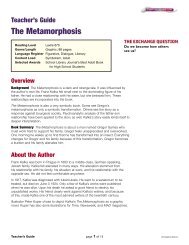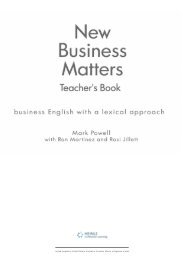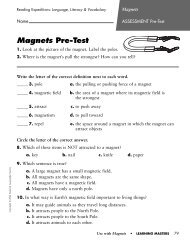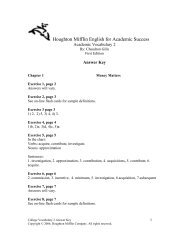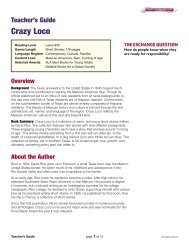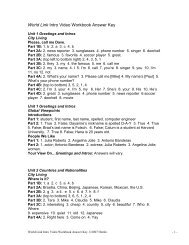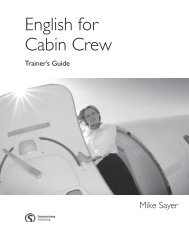Top 20, Great Grammar for Great Writing, First Edition Teaching Notes
Top 20, Great Grammar for Great Writing, First Edition Teaching Notes
Top 20, Great Grammar for Great Writing, First Edition Teaching Notes
Create successful ePaper yourself
Turn your PDF publications into a flip-book with our unique Google optimized e-Paper software.
Explain the <strong>for</strong>m. This tense always has present of BE plus an –ing <strong>for</strong>m. Explain thefour functions of present progressive tense. In Exercise 2, have students write their ownoriginal sentences or collect sentences from the web or from a printed source such as anewspaper or magazine.Present Perfect Tense (1.4)Explain the <strong>for</strong>m. This tense always has present of HAVE plus a past participle <strong>for</strong>m.(You may have to review past participle <strong>for</strong>ms. See appendix <strong>for</strong> a list of these <strong>for</strong>ms.)Explain the seven functions of present perfect tense. In Exercise 3, have students writetheir own original sentences or collect sentences from the web or from a printed sourcesuch as a newspaper or magazine.Present Perfect Progressive Tense (1.5)Explain the <strong>for</strong>m. This tense always has present of HAVE plus the past participle <strong>for</strong>mof BE plus an –ing <strong>for</strong>m of the verb. (You may have to review past participle <strong>for</strong>ms. Seeappendix <strong>for</strong> a list of these <strong>for</strong>ms.) Explain two common functions of present perfecttense. In Exercise 4, have students write their own original sentences or collect sentencesfrom the web or from a printed source such as a newspaper or magazine.Past Tense (1.6)Explain the <strong>for</strong>m. Have students give examples of regular and irregular verbs. Make acontest to see which pair or group can come up with the biggest list of verbs in a set timelimit (say 3 minutes). The two kinds of past tenses illustrated may not seem different toyou as an English speaker, but in some languages, they require different verb <strong>for</strong>ms whenstated in a series or list. In Exercise 5, have students write their own original sentences orcollect sentences from the web or from a printed source such as a newspaper ormagazine.More Expressions <strong>for</strong> Past Time: used to and would (1.6.1)Used to and would can often be used interchangeably. However, <strong>for</strong> a past verb that isnot an action, we usually use used to and not would. For example, we can’t say *“When Iwas a kid, I would hate onions.” In Exercise 6, you can have students write their ownoriginal sentences, but these verb <strong>for</strong>ms might be more salient to students if they have tocollect sentences from the web or from a printed source such as a newspaper ormagazine.Past Progressive Tense (1.7)2



